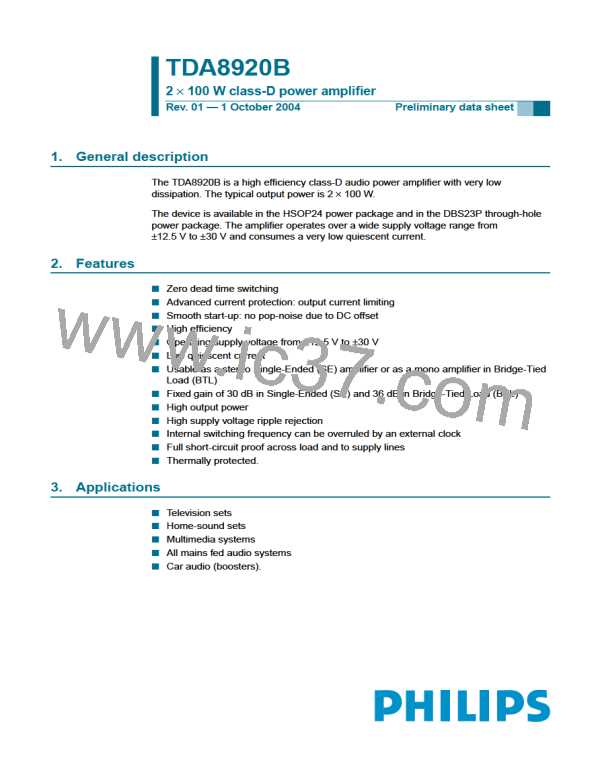TDA8920B
Philips Semiconductors
2 × 100 W class-D power amplifier
12.3 Mono BTL application
Table 10: Mono BTL application characteristics
VP = ±27 V; RL = 8 Ω; fi = 1 kHz; fosc = 317 kHz; RsL < 0.1 Ω [1]; Tamb = 25 °C; unless otherwise specified.
Symbol
Parameter
Conditions
Min
Typ
Max
Unit
[2]
[2]
[3]
Po
output power
RL = 6 Ω; VP = ±27 V
THD = 0.5 %
THD = 10 %
RL = 8 Ω; VP = ±27 V
THD = 0.5 %
THD = 10 %
Po = 1 W
-
-
174
210
-
-
W
W
-
-
138
173
-
-
W
W
THD
total harmonic distortion
fi = 1 kHz
-
0.02
0.03
36
0.05
-
%
fi = 6 kHz
-
%
Gv(cl)
closed loop voltage gain
35
37
dB
[4]
SVRR
supply voltage ripple rejection
operating
fi = 100 Hz
-
80
80
80
80
34
-
-
-
-
-
dB
dB
dB
dB
kΩ
fi = 1 kHz
70
-
[4]
[4]
mute; fi = 100 Hz
standby; fi = 100 Hz
-
Zi
input impedance
22
Vn(o)
noise output voltage
operating
Rs = 0 Ω
mute
[5]
[6]
[7]
-
-
-
-
300
220
200
75
-
-
-
-
µV
µV
µV
dB
Vo(mute)
CMRR
output signal in mute
common mode rejection ratio
Vi(CM) = 1 V (RMS)
[1] RsL is the series resistance of inductor of low-pass LC filter in the application.
[2] Output power is measured indirectly; based on RDSon measurement. See also Section 13.3.
[3] Total harmonic distortion is measured in a bandwidth of 22 Hz to 20 kHz, using an AES17 20 kHz brickwall filter. Maximum limit is
guaranteed but may not be 100 % tested.
[4] Vripple = Vripple(max) = 2 V (p-p); Rs = 0 Ω.
[5] B = 22 Hz to 20 kHz, using an AES17 20 kHz brickwall filter.
[6] B = 22 Hz to 20 kHz, using an AES17 20 kHz brickwall filter; independent of Rs.
[7] Vi = Vi(max) = 1 V (RMS); fi = 1 kHz.
13. Application information
13.1 BTL application
When using the power amplifier in a mono BTL application the inputs of both channels
must be connected in parallel and the phase of one of the inputs must be inverted (see
Figure 6). In principle the loudspeaker can be connected between the outputs of the two
single-ended demodulation filters.
9397 750 13356
© Koninklijke Philips Electronics N.V. 2004. All rights reserved.
Preliminary data sheet
Rev. 01 — 1 October 2004
15 of 34

 NXP [ NXP ]
NXP [ NXP ]